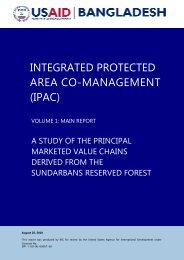Child Equity Atlas - BIDS
Child Equity Atlas - BIDS
Child Equity Atlas - BIDS
Create successful ePaper yourself
Turn your PDF publications into a flip-book with our unique Google optimized e-Paper software.
<strong>Child</strong> <strong>Equity</strong> <strong>Atlas</strong><br />
Two different Worlds:<br />
The Situation of <strong>Child</strong>ren in the Least and the Most Deprived Upazilas<br />
The situation of social development indicators in different geographic regions varies significantly,<br />
revealing two worlds. As in many countries, this <strong>Equity</strong> <strong>Atlas</strong> indicates that within Bangladesh, where<br />
children are born or live conveys the notion of different worlds in terms of access to certain services.<br />
This gulf in social deprivation is evident when the most deprived upazila is compared to the least<br />
deprived upazilas (see the table inside the box below). It is instructive to imagine what it means<br />
for a child to grow up in Alikadam upazila of Bandarban district compared to Boalkahali upazila of<br />
Chittagong district in the same division.<br />
The table below illustrates the extent of inequality between Alikadam and Boalkhali upazilas. Progress<br />
of some of the indicators in Alikadam is half as good as in Boalkhali, and the reality faced by children<br />
and their families due to the fate of their birth or place of abode. For instance, in Alikadam families<br />
have seven times less access to electricity and prevalence of the real child workers was 10 times more<br />
compared to those in Boalkhali. In all indicators presented, Alikadam is deprived in seven out of the<br />
eight parameters considered against none in Boalkhali.<br />
Comparison of situation between the most and the least deprived<br />
upazilas of same division<br />
Indicators (%) Alikadam upazila Boalkhali upazila<br />
<strong>Child</strong>ren under18 48 39<br />
Teenage marriage 32 15<br />
Youth literacy 43 83<br />
Female adult literacy 25 61<br />
Out of school children 39 16<br />
NAR secondary level 29 59<br />
Real child worker 21 2.2<br />
No sanitary toilet 76 17<br />
No electricity connection 84 12<br />
Number of deprivations 7 0<br />
8.1 Final Highlights, Observations and Key<br />
Recommendations<br />
8.1.1 Based on the study the following main<br />
observations are further highlighted:<br />
1. The <strong>Equity</strong> <strong>Atlas</strong> provides an insight with an<br />
incredible level of detail to the social situation<br />
of children, youth and their families in<br />
Bangladesh, based upon the 2011 Population<br />
Census. Substantial improvements have been<br />
noted between 2001 and 2011 in respect of<br />
most of the indicators taken into account<br />
(Table 1.2 in Chapter one). Disparities are<br />
more observable with further disaggregation<br />
by social groups and regions. Central to the<br />
atlas are the maps while the graphs show the<br />
remarkable progress achieved such as in the<br />
field of education and the closing of the gender<br />
118














